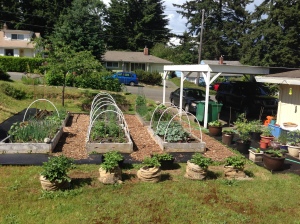Did you know it’s June 1st today? It totally sneaked up on me. I swear it was just 2-3 weeks ago that I wrote my last post and packed my bags for my Hawaii vacation. Guess not.
The Pacific Northwest has been blessed with some amazing weather this year. Normally in Seattle, summer doesn’t start until the 4th of July, but this year we hit 80 degrees in May! I only had to cloche my tomatoes for a week (I cloche at night until the nighttime temps are safely above 50 degrees). I’m blown away by how great my garden looks.
This spring I have been keeping myself busy in the garden. The hubs got inspired one Saturday and laid a whole bunch of landscaping fabric, took some leftover mulch from a neighbor and started mulching between our beds. The interesting part is apparently there are places that will give out free bark mulch. In Seattle there is a company who will deliver free bark mulch if they have to cut down trees for Seattle City Light in your neighborhood; there are also many arborists who will give out their bark mulch for free or at a small cost. The mulch we got was pretty rough, but I’ll take free over pretty any day.
The burlap sacks in the photo are growing potatoes. I can’t bear the thought of using an entire bed to grow potatoes so I’m trying my hand at the burlap sacks. The hardest part is knowing how often to water them. Potatoes are notorious for being sensitive to over-watering.
Every day I feel as though I’m drowning in weeds, raspberries and volunteer sunflowers. Please trust me that if you grow enormous sunflowers and you choose not to take them down in a timely manner, the critters in your neighborhood will spread the seeds for you. I have sunflower starts in EVERY SINGLE GARDEN BED. I do love my sunflowers though, and this spring a handful of neighbors have stopped by to ask me if the sunflowers will be back this year. Clearly, I can’t let them down.
The raspberries are also a new adventure. Last year I bought yellow raspberry starts from Burnt Ridge Nursery, and clipped some red raspberry starts from my dad. The starts from my dad have been in my family for generations. They come from Idaho, and the only other place I know where they grow is at the Monastery of St. Gertrude in Cottonwood, Idaho. The Monastery has a raspberry festival every year to celebrate. I keep meaning to go, but haven’t yet.
But I digress, I had no idea how much work it is to grow raspberries! They send up hundreds of shoots that I’ve had to pull. I do a walk through every 3-4 days and pull out the extras. I need to talk to my dad more about his trick, I think he goes along the edge of his raspberries with a sharp spade to cut all the underground sprouts.
I have continued to weigh all of my harvests this year, but with some modifications from last year. I’m not going to weigh any of the herbs. I already know those are financially worth it to grow, plus it’s way too easy to pad my numbers by harvesting pounds of herbs that I’ll never be able to use.
I’m also trying to categorize everything by varietal. For example, instead of just saying spinach, I specified if it was the Red Kitten or the Bloomsdale. I’m hoping this will help me narrow in on what we like best and grows best in my garden.
This year in May I harvested $56.74 worth of produce. It was mostly spinach, arugula (I ended up making a huge batch of arugula pesto when it all started bolting in the heat) and rhubarb. In 2013 I harvested $94.10 worth of produce, but it was about 75% herbs so I think I’m actually ahead of last year.
I’m saving the best for last. Today I harvested some of my Santé shallots! They weren’t necessarily ready to be harvested yet, but I was in the mood to put one in my kale. It tasted delicious.











